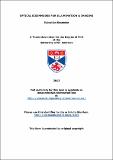Files in this item
Optical eigenmodes for illumination & imaging
Item metadata
| dc.contributor.advisor | Dholakia, Kishan | |
| dc.contributor.author | Kosmeier, Sebastian | |
| dc.coverage.spatial | 134 | en_US |
| dc.date.accessioned | 2013-02-28T14:50:17Z | |
| dc.date.available | 2013-02-28T14:50:17Z | |
| dc.date.issued | 2013-06-26 | |
| dc.identifier.uri | https://hdl.handle.net/10023/3369 | |
| dc.description.abstract | This thesis exploits so called “Optical Eigenmodes” (OEi) in the focal plane of an optical system. The concept of OEi is introduced and the OEi operator approach is outlined, for which quadratic measures of the light field are expressed as real eigenvalues of an Hermitian operator. As an example, the latter is employed to locally minimise the width of a focal spot. The limitations of implementing these spots with state of the art spatial beam shaping technique are explored and a selected spot with a by 40 % decreased core width is used to confocally scan an in focus pair of holes, delivering a two-point resolution enhanced by a factor of 1.3. As a second application, OEi are utilised for fullfield imaging. Therefore they are projected onto an object and for each mode a complex coupling coefficient describing the light-sample interaction is determined. The superposition of the OEi weighted with these coefficients delivers an image of the object. Compared to a point-by-point scan of the sample with the same number of probes, i.e. scanning points, the OEi image features higher spatial resolution and localisation of object features, rendering OEi imaging a compressive imaging modality. With respect to a raster scan a compression by a factor four is achieved. Compared to ghost imaging as another fullfield imaging method, 2-3 orders of magnitude less probes are required to obtain similar images. The application of OEi for imaging in transmission as well as for fluorescence and (surface enhanced) Raman spectroscopy is demonstrated. Finally, the applicability of the OEi concept for the coherent control of nanostructures is shown. For this, OEi are generated with respect to elements on a nanostructure, such as nanoantennas or nanopads. The OEi can be superimposed in order to generate an illumination of choice, for example to address one or multiple nanoelements with a defined intensity. It is shown that, compared to addressing such elements just with a focussed beam, the OEi concept reduces illumination crosstalk in addressing individual nanoelements by up to 70 %. Furthermore, a fullfield aberration correction is inherent to experimentally determined OEi, hence enabling addressing of nanoelements through turbid media. | en_US |
| dc.language.iso | en | en_US |
| dc.publisher | University of St Andrews | |
| dc.subject | Optics | en_US |
| dc.subject | Photonics | en_US |
| dc.subject | Beam shaping | en_US |
| dc.subject | Complex light | en_US |
| dc.subject | Spatial light modulator | en_US |
| dc.subject | SLM | en_US |
| dc.subject | Optical eigenmodes | en_US |
| dc.subject | Coherent control | en_US |
| dc.subject | Compressive imaging | en_US |
| dc.subject | Superresolution | en_US |
| dc.subject | Microscopy | en_US |
| dc.subject | Raman imaging | en_US |
| dc.subject | Nanoantenna | en_US |
| dc.subject | Optical degrees of freedom | en_US |
| dc.subject.lcc | QC355.3K7 | |
| dc.subject.lcsh | Optics | en_US |
| dc.subject.lcsh | Eigenvalues | en_US |
| dc.subject.lcsh | Photonics | en_US |
| dc.subject.lcsh | Light modulators | en_US |
| dc.subject.lcsh | Nanostructures | en_US |
| dc.title | Optical eigenmodes for illumination & imaging | en_US |
| dc.type | Thesis | en_US |
| dc.type.qualificationlevel | Doctoral | en_US |
| dc.type.qualificationname | PhD Doctor of Philosophy | en_US |
| dc.publisher.institution | The University of St Andrews | en_US |
This item appears in the following Collection(s)
Items in the St Andrews Research Repository are protected by copyright, with all rights reserved, unless otherwise indicated.

